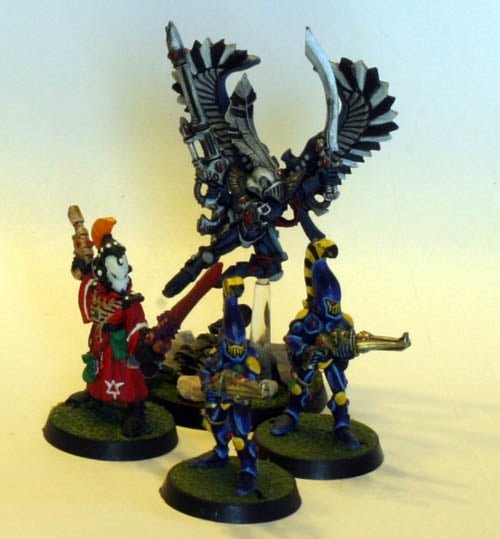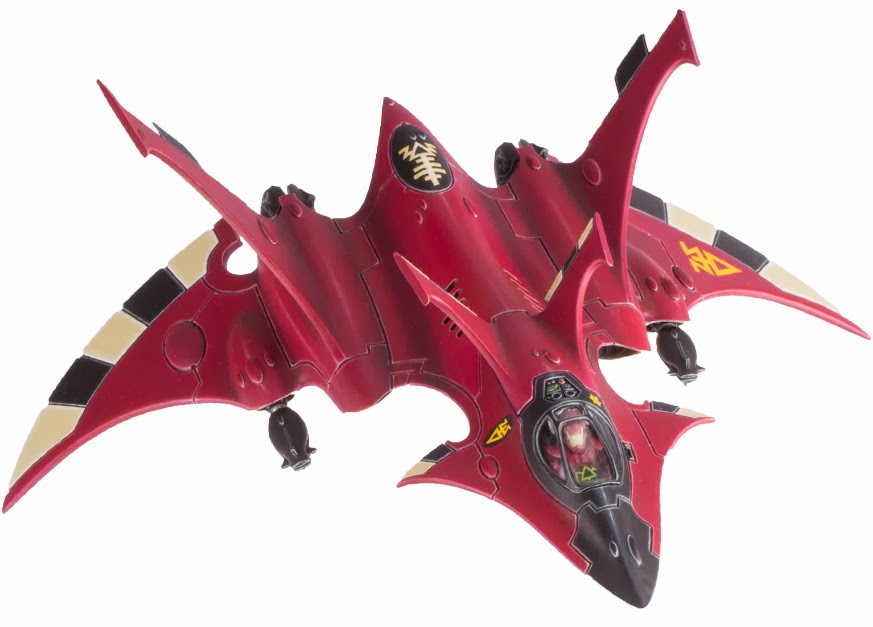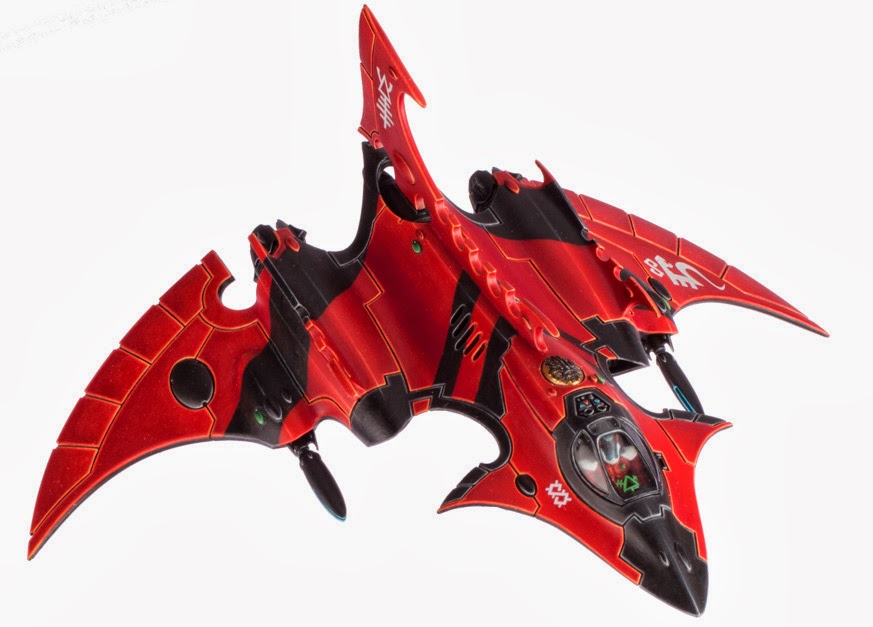40K TACTICS: Eldar FLYERS

Hey guys, I am Learn2Eel I’m here to continue our series on Codex: Eldar. The Craftworlders are back with a vengeance.
Eldar – Flyers
Crimson Hunter – The newest Eldar aspect and jester of the skies, the Crimson Hunter is the surest expression of a glass cannon; it hits harder than any flier has a right to, with the durability of a literal paper plane. Designed specifically for destroying fliers, the Hunter has some truly nasty anti-vehicular firepower; firing four Strength eight shots with an AP of two, half of which have the lance special rule, that are sure to wreck near any flier they hit short of a Storm Eagle. With most fliers sharing an armour value of eleven or so, it isn’t difficult to average two or so successful results on any flyer that, with the bonus to damage rolls, will usually at least force enemy fliers to evade and neuter them for the most part. Laughably, what really gives the Crimson Hunter such an edge against the opposition is that, provided the target is of the flyer type, the Hunter can re-roll failed armour penetration rolls against it. Given that each shot is already Strength eight, and that almost no flyer in the game has an armour value above twelve, the Hunter truly is a master of aerial combat. Against other vehicles, with its Ballistic Skill of four, it does decently well and will usually do some significant damage; that it is equipped with two bright lances gives it some strength against Land Raiders and Monoliths alike as well, making it truly versatile. Interestingly, you can give the Hunter some more love against monstrous creatures and elite infantry by switching the bright lances to starcannons; such an upgrade increases your rate of fire, but does lessen your viability against high armour vehicles and high toughness units.
A costly but nasty option for a Crimson Hunter is to upgrade it to an Exarch, granting it a Ballistic Skill of five that gives it a serious boost to its reliable firepower; averaging four hits on most turns and, with the re-rolls against fliers, effectively ensuring death to other aerial threats. Hilariously, this also allows the Crimson Hunter to fire Precision Shots similar to a regular character; with four Strength eight AP two shots at hand, this is very useful for singling out pesky characters like Necron Lords or even plasma or melta gunners. To add on to the joy, a Crimson Hunter has Vector Dancer; the first of two fliers to feature this coveted rule so far in a hardback codex, this gives it a ninety degree pivot after moving to increase its threat range and effectively “dance” around enemy fliers. For a flier as flimsy as the Crimson Hunter, this is absolutely essential; you can move on past an enemy flier and, with smart positioning to its flank, turn around and shoot at its exposed side or rear armour while preventing any chance of retaliation – unless ground forces or another flier enter the fray, of course. It gives it a large degree of aerial dominance, particularly when the strength and reliability of its weapons are concerned; this thing puts the hurt on fliers better than almost any other vehicle in the game. Some other situational upgrades available only to the Exarch, such as Night Vision and Marksman’s Eye, are cheap but ultimately not as worthwhile as you would hope; as a flier with a ridiculous movement speed, it is unlikely Night Vision will ever matter, while precision shots on a 5+ are handy but rather unnecessary. The Crimson Hunter should be firing at vehicles and fliers for the most part from the perspective of an all-comers army, and it truly is a sight to behold when in full flight. Generally speaking, the Crimson Hunter doesn’t benefit from vehicle upgrades as much as most others; it fires on the move at full efficiency all the time, while if it suffers a damage result it is more than likely about to be destroyed anyway.
Of course, such a flier has to have some disadvantages to balance it, and nowhere else is this more apparent than in the startling fragility of the Crimson Hunter. With an armour value of ten on all sides and three hull points, the Crimson Hunter is vulnerable to any weapon with the Strength or greater of a lowly bolter. To any kind of focused counter-attack, such as from another flier arriving from reserves or massed skyfire and snap shots of any kind, the Crimson Hunter will at the very least be forced to evade, let alone survive. You have to be careful even to place it near massed enemy Infantry lacking skyfire, as even a few hits could potentially spell doom – with some luck – for the sky hunter. Choosing between taking an easy kill shot or trying to preserve the flyer through careful movements will be an important tactical decision in each game; do you take the obvious flank and try to destroy an enemy flyer, or attempt to destroy it without exposing yourself to massed return fire from the ground or oncoming reserves? Most notable of the deterrents to a Crimson Hunter are Interceptor weaponry that can Skyfire, with the most popular by far being the Aegis Defence Line with the Quad Gun; against a competent firer, the Hunter will be forced to Evade and probably even destroyed regardless. To really maximise the incredible potential of the Crimson Hunter, such units must be identified and neutralized before it arrives; delaying it with an Autarch is a handy trick, while Rangers and the sheer number of anti-elite firepower Eldar bring should deal with Quad Guns and Skyfire units of most kinds. A risky unit indeed, but one that can easily obliterate a Vendetta or Night Scythe in a single volley; handle with care and make sure to build your list around dealing with enemy Interceptor weaponry.
Hemlock Wraithfighter – The freaky alternative to the Crimson Hunter, a Hemlock Wraithfighter is themed towards Wraith armies; piloted by a Spiritseer communing with the dead, it frightens opponents into…..uhh…..submission? I got nothing. Unlike the Hunter, the Wraithfighter is centred around fire support aimed at infantry and, generally, any unit that you simply just don’t like in general. With two heavy D-Scythes that fire Strength four AP two small blasts at a range of eighteen inches, it is actually somewhat versatile even with rather minimal weaponry. The Distort special rule allows these weapons to automatically wound or penetrate any model on a roll of a six, potentially inflicting instant death or destroying them outright. However, it can’t be expected to do serious damage against most enemies; it is useful mostly for decimating elite infantry somewhat reliably, though it shouldn’t be counted on solely for that. Like the Hunter, it has the Vector Dancer special rule to allow it a greater effective fire arc on the move; without the ability to hover – probably a good thing considering its fragility – this is handy for allowing it a better chance to survive against oncoming reserves while still firing away. Handily, it comes stock with Spirit Stones to ignore Shaken results on a 2+ and Stunned results on a 4+ – though it must be said that any kind of sustained ranged attack is likely to destroy the Wraithfighter outright.
What really defines the Wraithfighter is that it is, fittingly, a psychic vehicle; treated as a mastery level one psyker, it comes with only one predetermined power for use against a wide range of targets. The Terrify psychic power from the Telepathy rulebook discipline is a malediction with a range of twenty four inches that strips Fearless from an enemy unit, forces them to treat any enemy unit as causing Fear, and has to immediately take a morale check or fall back. Though not as useful on a unit with And They Shall Know No Fear as they still automatically pass Fear tests, this is handy against a wide range of units simply because it can make them run off the board or synergize well with your forces in combat. Combined with the Mindshock Pod that forces all units within twelve inches of the Wraithfighter to re-roll successful morale and pinning tests, and this is a rare unit in Warhammer 40000 that fights the enemy based on their Leadership, not their actual wounds or Toughness values. Combined with tank shocks from Wave Serpents, or multiple Pinning rounds from Warp Spider Exarchs or vibro cannons, and this is a strangely effective synergistic unit that works well when tailored for specific strategies. However, it lacks both the durability and the firepower to be impressive as an all-rounder unit, and as such it is a bit of a tough choice in an all comers army list as Eldar would typically be better served with the anti-air capabilities of the Crimson Hunter. As well, it is important to note that the Mindshock Pod also affects friendly units; given that Eldar have good, but not fantastic, Leadership scores across the board, positioning a Wraithfighter expertly is of the utmost importance so as not to sway a morale check against you and be the downfall of a given unit. Additionally, as it has to fly on from Reserve, it is unlikely – pending rules interpretations – that it can even use its Terrify psychic power on the turn it arrives, limiting its usefulness until the mid-game.
Like its kit sibling, the Wraithfighter is decidedly lacking in any manner of hardiness; though three hull points is useful for soaking up Perils of the Warp, it only adds to the ease with which enemies can focus fire it down. Though being a flyer does give it some decent basic defences against most units, any other flier with decent weaponry – even a Harpy with a Stinger Salvo is a surprising contender – can easily destroy the Wraithfighter, let alone Skyfire or Interceptor weaponry from Sabre Defence Platforms or Hydra Flak Tanks. As with the baby aspect, neutralizing such units before the Wraithfighter arrives from reserves should be one of your top priorities on the first turn; the Wraithfighter can be devastating in the right hands, but not if it is destroyed before it can accomplish anything. Somewhat disappointingly, the short range of its main guns – not that they are key to the stated purpose of the Wraithfighter – effectively doom it to the rapid fire range of most weapons which, with numbers to back them up, stand a decent chance of destroying the Wraithfighter. Though it would take an average of dozens of bolter shots to destroy a Wraithfighter on full hull points, the risk is nonetheless there and all it takes is a few lucky shots for you to be forced to Evade. Unlike the Hunter, the Wraithfighter isn’t as concerned with shooting and as such it is not a great loss to Evade; surviving is key, and sacrificing the heavy d-scythes to utilize the mindshock pod and Terrify power will usually be an easy trade. Though it is not the best flier, it is one that will work particularly well in an army themed around forcing lots of Fear, Pinning and Morale tests; Howling Banshees, Warp Spiders, Dark Reapers and many others gain noteworthy boosts to their effectiveness from the inclusion of a Wraithfighter. Though expensive, these benefits may be worth it provided you can tailor them to your needs.
Next time – Eldar Heavy Support
I hope you found my thoughts on the Eldar helpful. You can read way more about Codex Eldar, and we are open to any and all responses! So how do you run those hypersonic flyers fellow Craftworlders?




